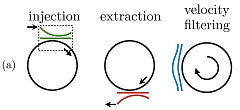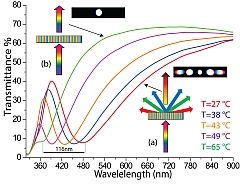Accueil
Ultra-cold atom transport made simple (Vol. 45 No.4)
 Schematic representation of the physical system consisting of a ring trap and two dipole waveguides for injecting neutral atoms into, extracting them from, and velocity filtering them in the ring waveguide. Credit: Loiko et al.
Schematic representation of the physical system consisting of a ring trap and two dipole waveguides for injecting neutral atoms into, extracting them from, and velocity filtering them in the ring waveguide. Credit: Loiko et al.
New study provides proof of the validity of a filtering device for ultra-cold neutral atoms based on tunnelling.
A new study gives a proof of principle, confirmed by numerical simulations, of the applicability to ultra-cold atoms of a very efficient and robust transport technique called spatial adiabatic passage (SAP). The authors have, for the first time, applied SAP to inject, extract, and filter the velocity of neutral atoms from and into a ring trap.
They focused on controlling the transfer of a single atom between the outermost waveguides of a system composed of two dipole waveguides and a ring trap, using the SAP technique. They calculated the explicit conditions for SAP tunnelling, which depend on two factors: the atomic velocity along the input waveguide and the initial atom population distribution among what physicists refer to as the transverse vibrational states.
To check the performance of the proposed approach, they relied on a numerical integration of the corresponding equation with parameter values for rubidium atoms and an optical dipole ring trap.
Y. Loiko, V. Ahufinger, R. Menchon-Enrich, G. Birkl and J. Mompart, “Coherent injecting, extracting, and velocity filtering of neutral atoms in a ring trap via spatial adiabatic passage”, Eur. Phys. J. D, 68, 147 (2014)
[Abstract]
Tuneable broadband optical filter based on soft-composite materials (Vol. 45 No.4)
 Spectral response versus temperature and schematic rapresentation of the filter mechanism in states ON (a) and OFF (b).
Spectral response versus temperature and schematic rapresentation of the filter mechanism in states ON (a) and OFF (b).
We realized a free-space, polarization sensitive, broadband, widely tunable, optical filter by exploiting a micro-composite holographic grating made of polymer slices alternated with films of aligned Nematic Liquid Crystals (NLC). Impinging probe light (p-polarized) experiences a refractive index modulation (Δng); thus, it is transmitted/diffracted and, consequently, angularly separated into its fundamental colours, according to the sketch of Figure (a). This diffraction effect induces a band-gap behaviour (filter in the ON state) in the transmission properties featured by the structure (Figure (a), red curve) and in the corresponding far field diffraction pattern. Both electric fields and temperature variations can be exploited to tune the position of the diffractive band-gap; in particular, by increasing the sample temperature, a nematic to isotropic transition of the NLC component gradually reduces Δng, with a resulting blue shift and a gradual suppression of the diffraction band (Figure (a), green curve). Under these conditions, light is almost completely transmitted (filter in the OFF state) as shown in the far field diffraction pattern and in the corresponding sketch reported in Figure (b).
L. De Sio, V. Caligiuri and C. Umeton, “Tuneable broadband optical filter based on soft-composite materials”, J. Opt., 16, 065703 (2014)
[Abstract]
Transparent conducting device for electromagnetic waves (Vol. 45 No.4)
It is highly desirable to make a metal transparent for electromagnetic waves, owing to many application requests for transparent metals in optoelectronics devices. However, it is well known that a high-conducting metal with a high electron density is generally opaque for electromagnetic waves, since the metal’s permittivity is generally very negative at optical frequencies. Here, a freestanding transparent conducting device based on multilayer metamaterials is theoretically demonstrated at terahertz frequencies. It is realized by depositing periodic metallic patches on top and bottom of the subwavelength metallic mesh. The high transmission of the designed system is attributed to the impedance matching to the vacuum. This design of a transparent conducting device opens a high transmission window within the technologically relevant THz frequency range. This device may find plenty of applications in optoelectronic electrodes, micro-electronic displays, and the miniaturization and integration of THz components, where both high electrical conductivity and high optical transmission are desirable.
Z. Song, Z. Gao, Y. Zhang and B. Zhang, “Terahertz transparency of optically opaque metallic films”, EPL, 106, 27005 (2014)
[Abstract]
Particles near absolute zero do not break the laws of physics (Vol. 45 No.4)
 A free particle strongly coupled to a heat bath. Credit: Adamietz et al.
A free particle strongly coupled to a heat bath. Credit: Adamietz et al.
A change of models demystifies anomalous particle behaviour at very low temperatures, confirming that the third law of thermodynamics cannot be violated
In this work, the authors have demonstrated that a theoretical model of the environment’s influence on a particle does not violate the third law of thermodynamics, despite appearances to the contrary. These findings are relevant for systems at the micro or nanometer scale that are difficult to decouple from the heat or the quantum effects exerted by their environment.
Previous theoretical predictions suggested that, under certain circumstances, the specific heat—the amount of energy is needed to raise the temperature of a particle coupled to a heat bath by a certain amount—can decrease below zero at strictly zero temperature (−273.15 °C). This prediction appears to breach the third law of thermodynamics, indicating that the specific heat must drop to zero value at strictly zero temperature. Yet, these findings show that previous studies need to be modified in order to account for a spatial confinement of the particle.
R. Adamietz, G.-L. Ingold and U. Weiss, “Thermodynamic anomalies in the presence of general linear dissipation: from the free particle to the harmonic oscillator”, Eur. Phys. J. B, 87, 90 (2014)
[Abstract]







